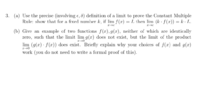sad.ib.kid
New member
- Joined
- Dec 17, 2019
- Messages
- 3
Hi folks! Me and all my other classmates are struggling with this one problem on the homework. I do understand the precise definition and the constant multiple rule and am comfortable with solving problems that involve either one of them. However, it racks my brain when the two concepts are put into one question and I am stumped. Thank you in advance if you choose to help me, I really appreciate it as a stressed college student <3 

